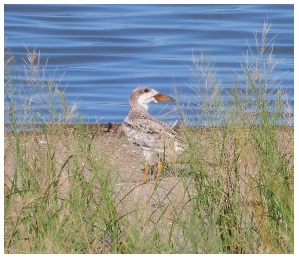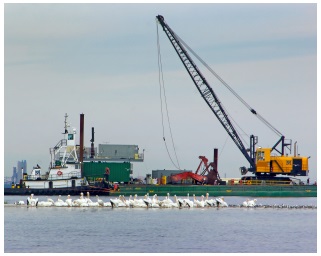Environment: New Orleans, Seattle, Tampa
![]() Print this Article | Send to Colleague
Print this Article | Send to Colleague
Port of New Orleans Grant from EPA Provides Financial Incentives to Replace Older Drayage Trucks
The Port of New Orleans’ newly launched Clean Truck Replacement Incentive Program (Clean TRIP) offers financial incentives for local short-haul truck owners to voluntarily replace approximately 20 Class 8 drayage trucks from model years 1993-2006 with trucks from model year 2012 and newer.
The cost-share program provides 50 percent of the vehicle sale cost (up to $35,000) for a maximum of two trucks per owner or fleet. It is open to truckers who service cargo terminals and warehouses along the Mississippi River and the Industrial Canal.
The Clean TRIP program is part of a $727,000 Clean Diesel competitive grant from the U.S. Environmental Protection Agency to the port. The grant supports the local port trucking community; helps reduce local air emissions and increases reliability and efficiency of on-road goods movement. The program also provides an opportunity for community discussion and outreach about air quality.
Total project cost is $1.537 million, with $700,000 coming from mandatory cost-share with eligible truck owners and $110,636 from the port for administrative costs. Key local partners in the two-year program include the Regional Planning Commission, Louisiana Department of Environmental Quality, Deep South Center for Environmental Justice, University of New Orleans and the Environmental Defense Fund.
"This program is a win-win," said Port President and CEO Gary LaGrange, PPM®. "Local trucking companies can replace inefficient vehicles cost-effectively with commensurate emissions reductions and we have the opportunity to start a conversation about air quality."
Seattle: Port Commission Approves Funding for Design of First Solar Project on Port Property
The Port of Seattle Commission on September 13 approved funding for design of the port’s first-ever solar demonstration project. The project at Fishermen’s Terminal is part of a routine replacement of net-shed roofs. The sheds house fishing nets and gear for the North Pacific Fishing Fleet.
"As we explore innovative policies to guide the reduction of our carbon footprint, I am encouraged that this demonstration project could lead the way for additional solar project opportunities at the port in the future," said Port Commissioner Fred Felleman.
Planners estimate that the net-shed solar panels could produce 11,000 kilowatts of electricity per year while reducing carbon emissions by 279 pounds in the first year. The project could be in place by the end of 2017.
The demonstration project will help the port gain in-house knowledge about the benefits and challenges of solar projects, including installation, operation, and maintenance. The design will also include public education components that create visual awareness of the benefits of solar power.
Engineers are also looking at the feasibility of installing solar panels at Pier 69, the Port of Seattle headquarters on the Seattle Waterfront, and other port properties. The potential exists to offset carbon emissions by hundreds of thousands of pounds per year, reducing greenhouse gases that lead to climate change.
Port Tampa Bay, Audubon Florida Report the Successful Completion of Multiple Projects While Protecting Nesting Birds

A black skimmer chick as seen on dredge disposal island 3D in Port Tampa Bay
Photo/Lorraine Margeson, Lg2/contractor, Cashman Dredging/USACE
The islands provide protected nesting habitat for American Oystercatchers and many other sea bird species to complete their reproductive cycle. Each year, the islands become one of the bay area’s prime nesting sites, this year hosting possibly thousands of nesting migratory birds.
"This year saw nesting by 35 pairs of oystercatchers, thousands of pairs of gulls, five species of terns, and approximately 100 pairs of Black Skimmers," reports Mark Rachal of Audubon Florida.
The nesting population of oystercatchers on the dredge disposal islands is the largest in the state, according to surveys conducted by Audubon and the Florida Fish and Wildlife Conservation Commission. Oystercatchers remain one of Florida’s rarest species, with fewer than 400 pairs in the state. This season, oystercatchers on Island 2D successfully raised at least three chicks. In addition, approximately 111 Black Skimmer and 9 Least Terns fledges were reported on Island 3D by a contractor for the U.S. Army Corps of Engineers.
Working closely with many key partners, the port authority has an integral role in the restoration, improvement and protection of the environmental health of Tampa Bay.
"In keeping with a firm commitment to the health and vitality of the waters around Tampa Bay and the native species that thrive there, we at the port will continue to engage in meaningful, long-term initiatives that sustain and improve life in these delicate habitats," said Port Authority CEO Paul Anderson.

Maintenance dredging at the Alafia Bank area of Tampa Bay, with equipment and American White pelicans, gulls and terns in the foreground.
Photo/Mark Rachal, Audubon Florida
The Port of New Orleans’ newly launched Clean Truck Replacement Incentive Program (Clean TRIP) offers financial incentives for local short-haul truck owners to voluntarily replace approximately 20 Class 8 drayage trucks from model years 1993-2006 with trucks from model year 2012 and newer.
The cost-share program provides 50 percent of the vehicle sale cost (up to $35,000) for a maximum of two trucks per owner or fleet. It is open to truckers who service cargo terminals and warehouses along the Mississippi River and the Industrial Canal.
The Clean TRIP program is part of a $727,000 Clean Diesel competitive grant from the U.S. Environmental Protection Agency to the port. The grant supports the local port trucking community; helps reduce local air emissions and increases reliability and efficiency of on-road goods movement. The program also provides an opportunity for community discussion and outreach about air quality.
Total project cost is $1.537 million, with $700,000 coming from mandatory cost-share with eligible truck owners and $110,636 from the port for administrative costs. Key local partners in the two-year program include the Regional Planning Commission, Louisiana Department of Environmental Quality, Deep South Center for Environmental Justice, University of New Orleans and the Environmental Defense Fund.
"This program is a win-win," said Port President and CEO Gary LaGrange, PPM®. "Local trucking companies can replace inefficient vehicles cost-effectively with commensurate emissions reductions and we have the opportunity to start a conversation about air quality."
Seattle: Port Commission Approves Funding for Design of First Solar Project on Port Property
The Port of Seattle Commission on September 13 approved funding for design of the port’s first-ever solar demonstration project. The project at Fishermen’s Terminal is part of a routine replacement of net-shed roofs. The sheds house fishing nets and gear for the North Pacific Fishing Fleet.
"As we explore innovative policies to guide the reduction of our carbon footprint, I am encouraged that this demonstration project could lead the way for additional solar project opportunities at the port in the future," said Port Commissioner Fred Felleman.
Planners estimate that the net-shed solar panels could produce 11,000 kilowatts of electricity per year while reducing carbon emissions by 279 pounds in the first year. The project could be in place by the end of 2017.
The demonstration project will help the port gain in-house knowledge about the benefits and challenges of solar projects, including installation, operation, and maintenance. The design will also include public education components that create visual awareness of the benefits of solar power.
Engineers are also looking at the feasibility of installing solar panels at Pier 69, the Port of Seattle headquarters on the Seattle Waterfront, and other port properties. The potential exists to offset carbon emissions by hundreds of thousands of pounds per year, reducing greenhouse gases that lead to climate change.
Port Tampa Bay, Audubon Florida Report the Successful Completion of Multiple Projects While Protecting Nesting Birds

A black skimmer chick as seen on dredge disposal island 3D in Port Tampa Bay
Photo/Lorraine Margeson, Lg2/contractor, Cashman Dredging/USACE
Port Tampa Bay is marking the close of another successful nesting season for migratory birds that make the port’s dredged material management areas their summer home in Hillsborough Bay. The official nesting season runs from April 1 through August 31 and represents a cooperative effort between the port authority, Audubon Florida, the U.S. Army Corps of Engineers, the Florida Fish and Wildlife Conservation Commission, and other local, state, and federal agencies.
"This year saw nesting by 35 pairs of oystercatchers, thousands of pairs of gulls, five species of terns, and approximately 100 pairs of Black Skimmers," reports Mark Rachal of Audubon Florida.
The nesting population of oystercatchers on the dredge disposal islands is the largest in the state, according to surveys conducted by Audubon and the Florida Fish and Wildlife Conservation Commission. Oystercatchers remain one of Florida’s rarest species, with fewer than 400 pairs in the state. This season, oystercatchers on Island 2D successfully raised at least three chicks. In addition, approximately 111 Black Skimmer and 9 Least Terns fledges were reported on Island 3D by a contractor for the U.S. Army Corps of Engineers.
Working closely with many key partners, the port authority has an integral role in the restoration, improvement and protection of the environmental health of Tampa Bay.
"In keeping with a firm commitment to the health and vitality of the waters around Tampa Bay and the native species that thrive there, we at the port will continue to engage in meaningful, long-term initiatives that sustain and improve life in these delicate habitats," said Port Authority CEO Paul Anderson.

Maintenance dredging at the Alafia Bank area of Tampa Bay, with equipment and American White pelicans, gulls and terns in the foreground.
Photo/Mark Rachal, Audubon Florida

